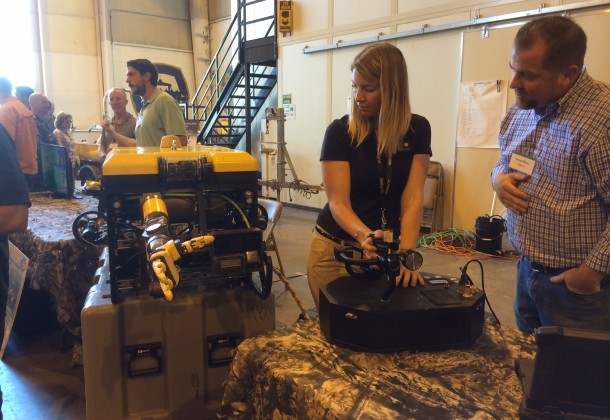Warfighting Edge, Operator Safety UUV Priorities

The murky waters around Naval Air Station Patuxent River create the perfect testing environment for Unmanned Underwater Vehicles built to neutralize danger and protect the lives of their operators.
The Office of Naval Research’s recent technology expo, PAX River 2015, illustrated just how important operator and diver safety is in that dark underwater world. In developing new technologies, minimizing risk has become as important as finding what NAS Patuxent River CO Heidi Fleming calls,“that war-fighting edge.”
CAPT Fleming lauded advances in “underwater imagery and sonar to get us information on critical underwater structures. We have video and infrared. It’s about getting data to make us better as a nation and as a war fighter.”
On exhibit were more than 40 underwater and surface vehicles and remotely operated detection devices that show promise for advancing to manufacture and deployment. Also present were representatives of the five-nation Technical Cooperation Program (United States, Great Britain, New Zealand, Australia, and Canada) who collaborate to cross-pollinate military research programs and at-sea experimentation.
“Robotics technology is moving at a very past pace,” said Robert Gibson, PAX River 2015 project manager. According to Mr. Gibson, military and commercial sectors are drastically increasing investments in unmanned systems, autonomy, automation and systems-of-systems solutions.
PAX River 2015 facilitated interactions between the user and developer communities, making it possible to observe the technologies in their intended environments.
On particular display at the PAX River were miniaturization of sensing technology and the ingenuity involved to keep underwater danger away from divers and operators.
The 2015 breakout technologies features included:
— A submerged threat identification and neutralization surface vessel and underwater robot duo (STID-N). The vessel is a small, double-hulled craft managing an R2D2-type underwater-type vehicle. The Pax River testing was STID-N’s first in a realistic environment, the equivalent of a mission situation. Testing hit a bump when a docking collar on the surface vessel broke. A 3-D printer saved the day, cranking out a replacement part in five hours. The STID-N’s value is an increased stand-off distance for operators and the ability to run “detect to engage” scenarios.
— Similar to the STID-N is a sensor-based, stabilized remotely operated vehicle with a manipulator arm to disable a threat. The arm flexes like a human arm, with a wrist-hand dexterity able to access tight spaces in underwater structures.
— A show-stopper was a highly dexterous manipulation system able to mimic the upper human body. The HDMS operator dons a small chassis to operate a function similar to 52-foot human arms able to lift more than 100 pounds. Its dexterity can unscrew container lids, open bags and packages, and reach into areas too small, and too dangerous, for divers.
— A good example of the miniaturization of detection technology is the Riptide micro-UUV, just three feet long, weighing 20 pounds. It has applications for marine surveying, oceanography and mine neutralization.
— The long sought ability to detect surface and near-surface ocean mines is improved by the compact modular sensing and processing system. Attached to a helicopter, in a single pass, the system can obtain a reliable prediction of mine activity.























